It’s 5 o’clock on a Friday afternoon, and Gypsy Gold is heading to work. As the 17-year-old Morgan-Brabant draft horse clip-clops through the Five Points neighborhood, residents wave and call out greetings. Children stare.
“Hi, Gypsy!” shouts a Checker Cab driver, slowly overtaking the carriage.
After patiently waiting for the light at Five Points, Gypsy turns onto Broadway. A purple LaZoom bus passes; passengers echo the tour guide’s amplified “Hi, Gypsy!” As we pull up to the carriage stand alongside Pritchard Park, police officers, a park warden and emergency medical responders also greet Gypsy and owner/driver Catherine Hunter.
After blocking the wheels and recording Gypsy’s temperature, Hunter, who owns Asheville Horse & Carriage Tours, takes up a position at the bay gelding’s head, turning her attention to the constant stream of admirers eager to pat and take selfies with Gypsy. As the horse offers his nose for kisses and his neck for stroking, Hunter chats with passers-by. “Some of the money we earn helps rescue abused horses,” she tells a couple visiting from St. Petersburg, Florida.
Asheville natives Bob and Bobbie Ray walk up to redeem a gift certificate their daughter gave them. Halfway through the ride, Bobbie says she’s seen art deco details she’d never noticed before and has taken note of Hunter’s restaurant recommendations.
Returning to Pritchard Park, Hunter thanks the Rays and checks Gypsy over. Then she’s back at the horse’s head, greeting potential customers and welcoming curious children.
Not everyone, however, is charmed by the sight of a horse and carriage in downtown Asheville: Some say they’re unhealthy, unsafe and exploitative.
Protest planned
A planned protest against Hunter’s operation by Asheville Voice for Animals activists was rained out, but the group has twice screened Blinders, an anti-horse-carriage-industry film, and plans to hold a protest in November, notes campaign manager Sarah Windle.
“Horses shouldn’t be walking on pavement; the excessive pounding is hard on their hooves and legs and leads to lameness. And they shouldn’t be forced to live nose-to-tailpipe, breathing noxious vehicle emissions,” says longtime local animal welfare crusader Stewart David. “Forcing a horse to pull a carriage full of people uphill is cruel, and doubly cruel in hot weather. While the ordinance restricts their use during periods of extreme heat and cold, enforcement of this and other regulations is, to the best of my knowledge, almost nonexistent.”
But Sue D. McMullen, the city’s animal services supervisor, says that’s not true. Since Hunter received her carriage horse license in 2013, says McMullen, “Our department has received three complaints. We’ve investigated: They were all unfounded. People see it’s hot out, maybe the horse is foaming at the mouth a little bit,” she explains, but there’ve been no accidents or violations.
Although the city approved carriage tours in 1993, Hunter and her business hold the only current licenses, says APD Public Information Officer Christina Hallingse. Both carriage and horse must be inspected annually.
AVA co-organizer Gregory Prescott, however, believes Hunter’s clean record is beside the point. “Regardless of what conditions the horses are living in, or what kind of space she claims they may have or how well they’re taken care of when they’re not on the street,” he maintains, “That’s not the issue at all.”
Home on the farm
For Hunter, though, the care of her animals is very much the issue.
“I’m not in the horse industry to get rich,” she deadpans, gesturing toward her two-room apartment upstairs in the barn on the 30-acre Weaverville farm she leases. “I drive a 16-year-old car; I buy my clothes at Goodwill. All the money from the carriage operation goes back into the horses. Proper care for one horse costs at least $200 to $300 per month: What do those people think will happen to these horses without a job?”
Gypsy starts the day in the pasture he shares with about 10 other horses. Although there’s a large shelter in the pasture, the horses usually choose to stay in the open in all sorts of weather, says Hunter.
Before calling them to the barn for breakfast, she fills each roomy stall’s feed bucket with locally grown whole oats. “We use a lot of rewards in our training,” Hunter explains, noting that a calm, happy horse cooperates willingly, eliminating the need for harsh tactics.
After eating, Gypsy receives a thorough grooming.
The gelding pulled carriages in St. Augustine, Florida, for 11 years before his owners decided to retire. “They didn’t want to sell their horse to anyone but me,” recalls Hunter, who also bought two carriages from them.
Gypsy works no more than eight hours a day, five days a week. He gets a 15-minute water and rest break every two hours. Regulations say he can’t work when the temperature is above 90 or below 25 degrees, and he gets two months off in winter.
A horse, says Hunter, can pull up to six times its own weight. Gypsy tips the scales at 1,350 pounds, she points out, so his maximum load (six adult passengers in a 900-pound carriage) is about a quarter of what he could theoretically pull. “It’s about the same as a person pushing a shopping cart,” she says. Special shoes give him extra traction on pavement, and a skilled farrier sees him every four to six weeks.
“It’s not true that horses can’t tell you if they don’t want to work,” notes Hunter. “If he didn’t want to get in that trailer, there’s nothing I could do to force him.”
As evidence, Hunter offers to demonstrate. The horse’s ears prick forward when he hears the truck’s diesel engine start; he walks to the door of the green two-horse rig on a loose lead rein. Hunter barely has a chance to praise him with a “Good boy!” before the bay gelding steps up into the trailer, his lead rope slack as Hunter waits by the door.
Gypsy stands inside quietly; at the “Back up!” command, he steps out of the trailer as calmly as he went in.
Hunter says she appreciates the protesters’ concern but wishes it were directed toward the thousands of horses genuinely in need of an advocate, noting, “I’d be the first person protesting if someone were mistreating a horse.”



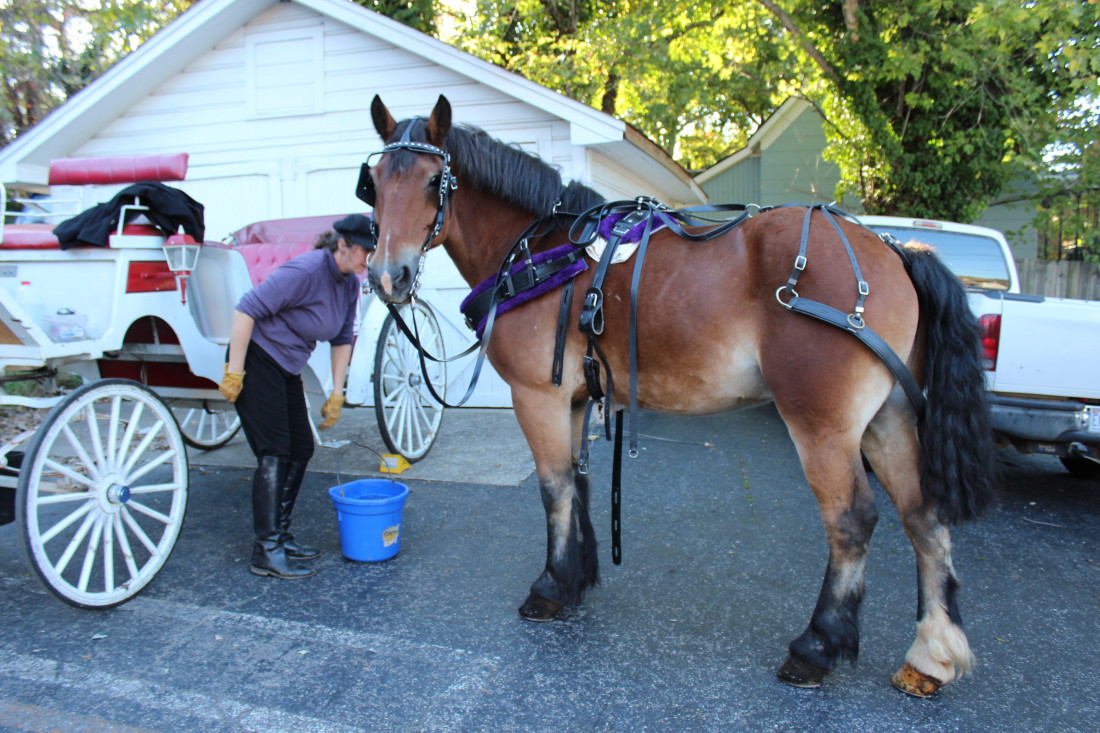

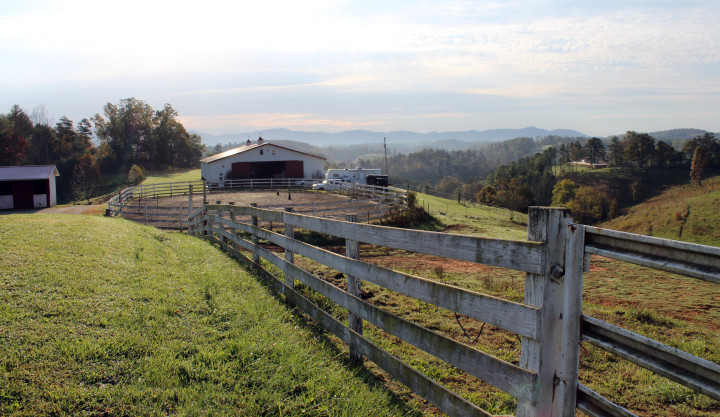
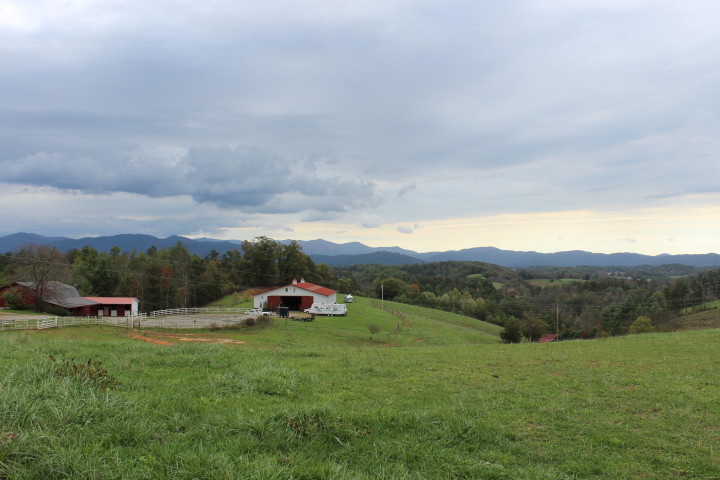
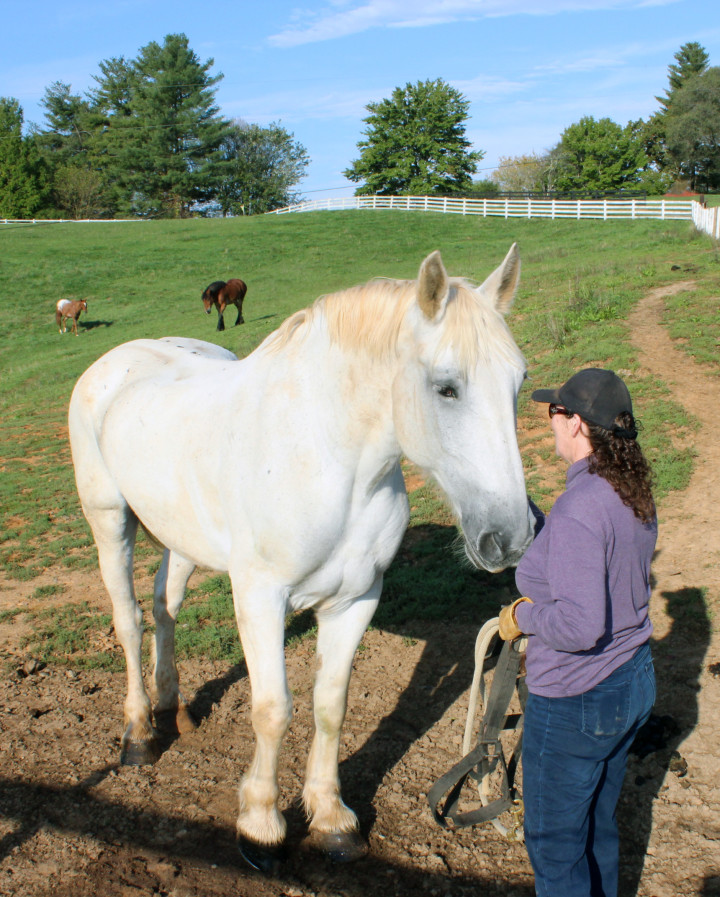
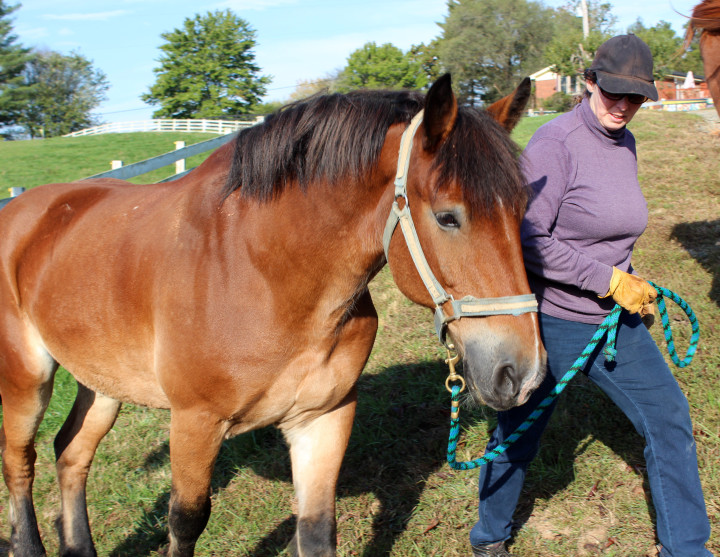
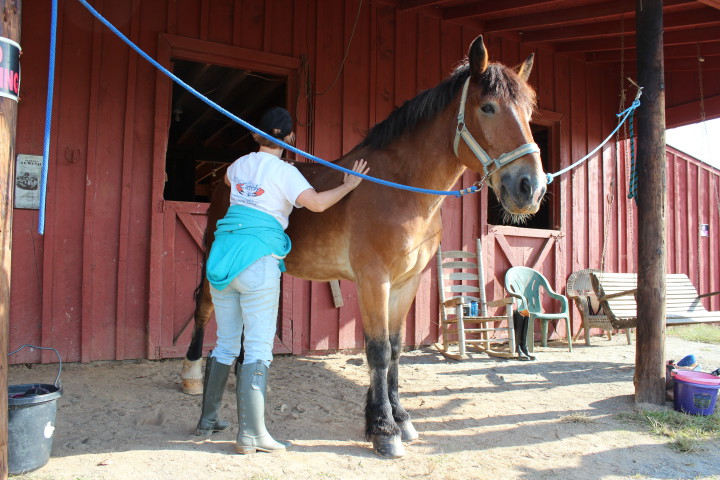
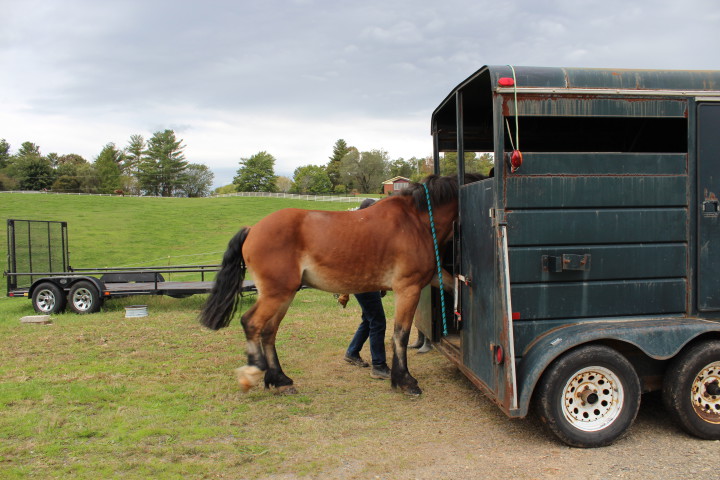
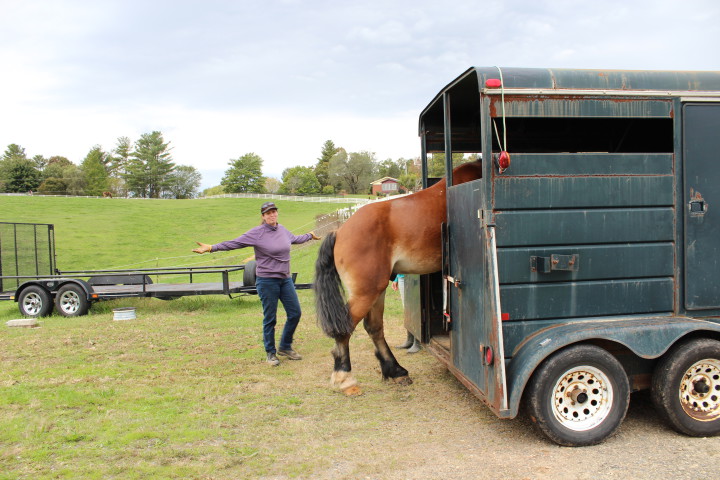
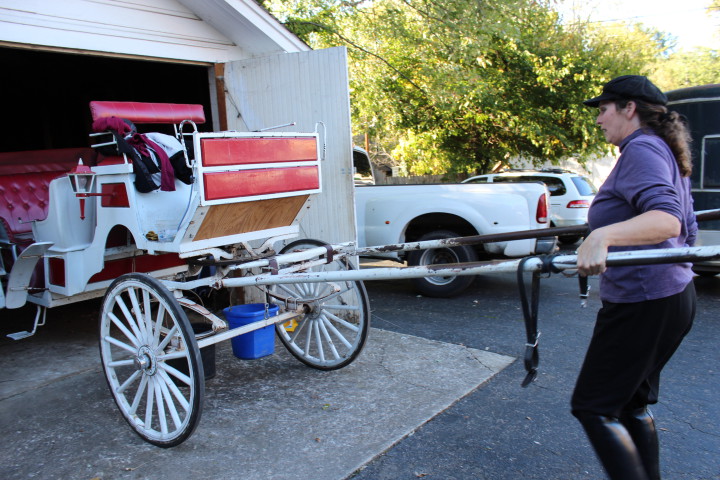
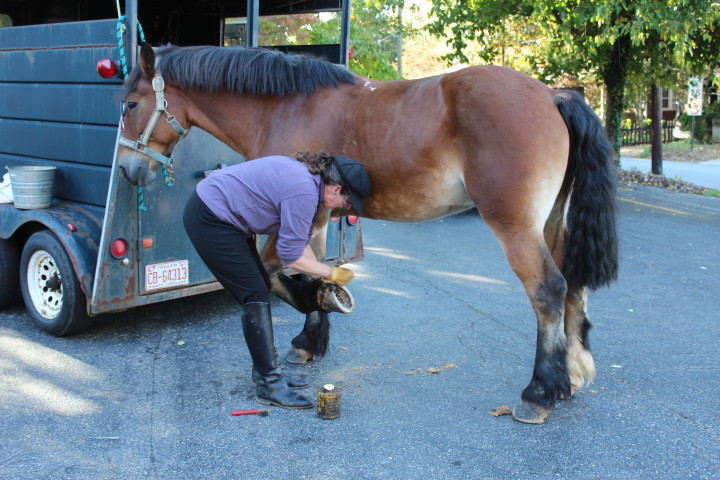
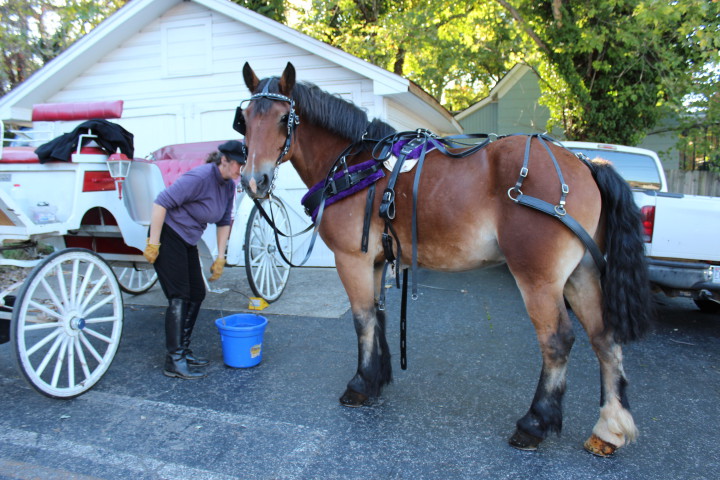
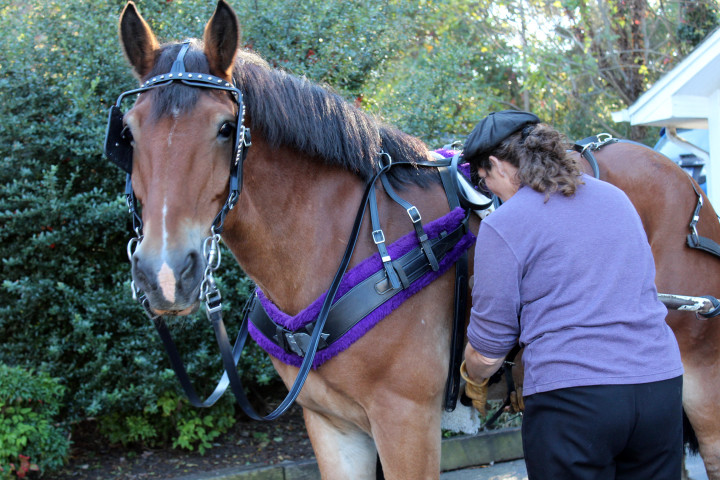
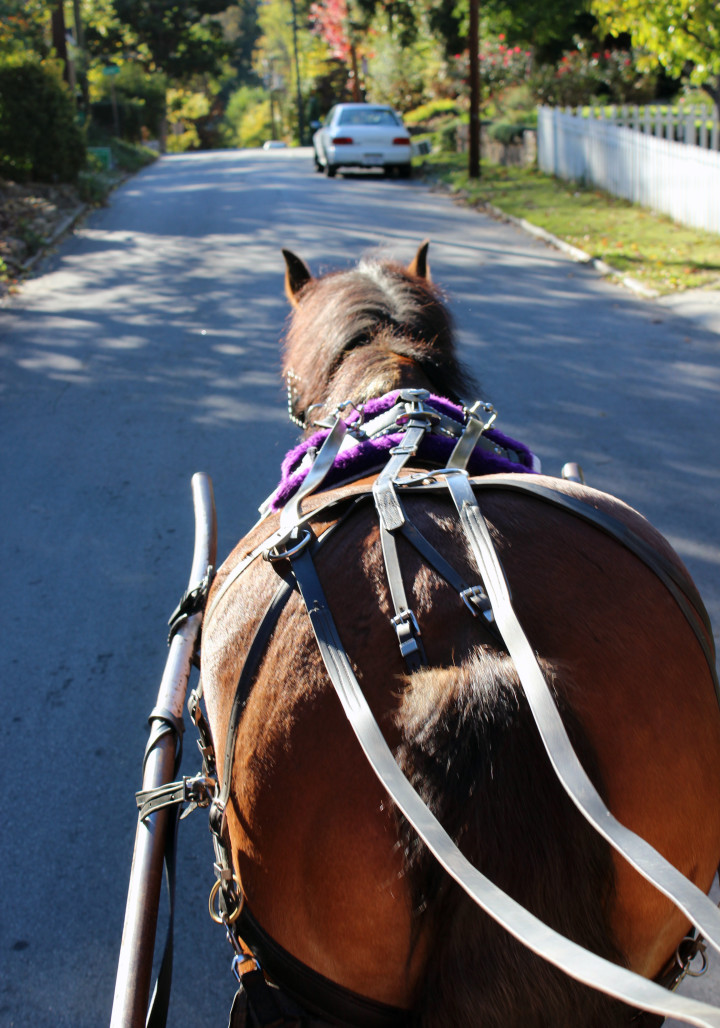
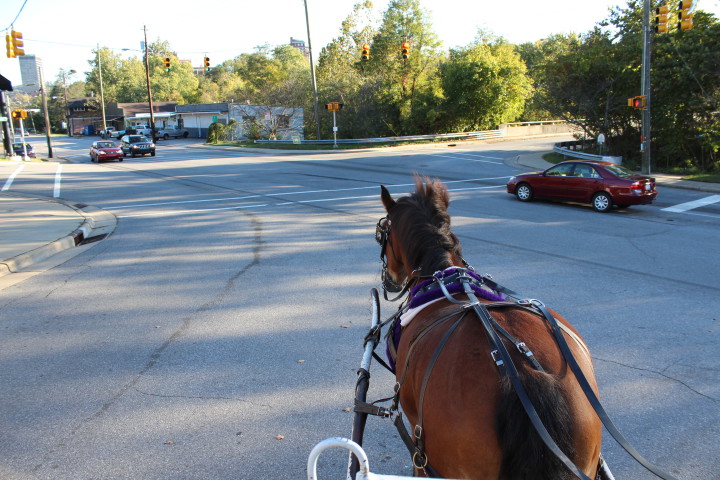
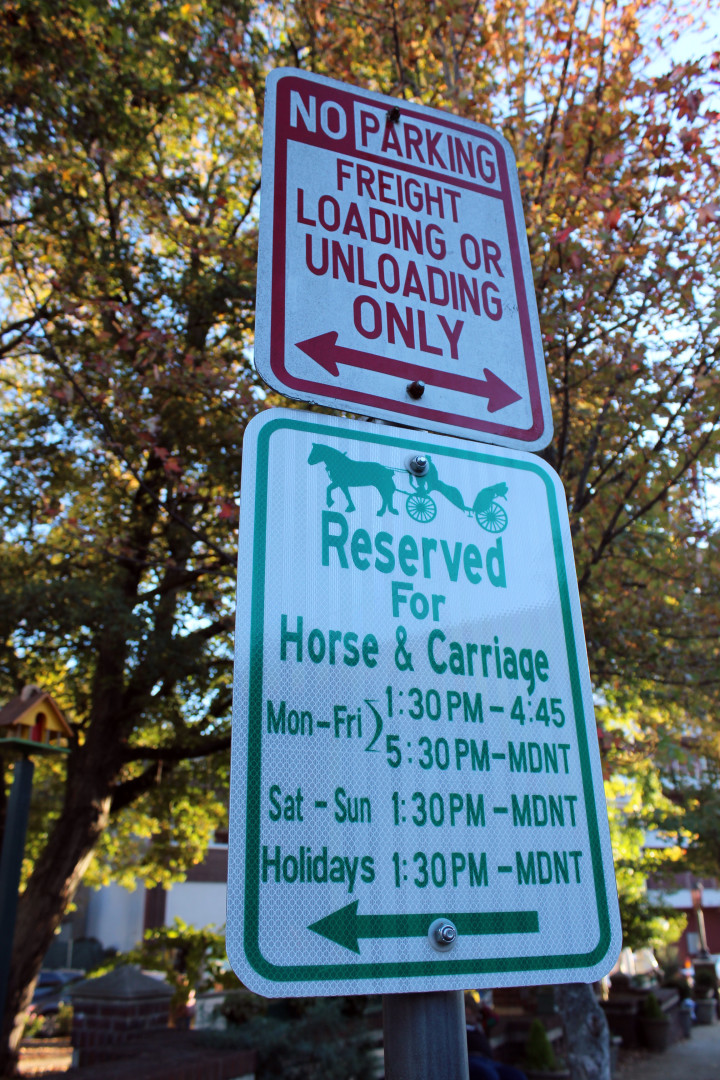
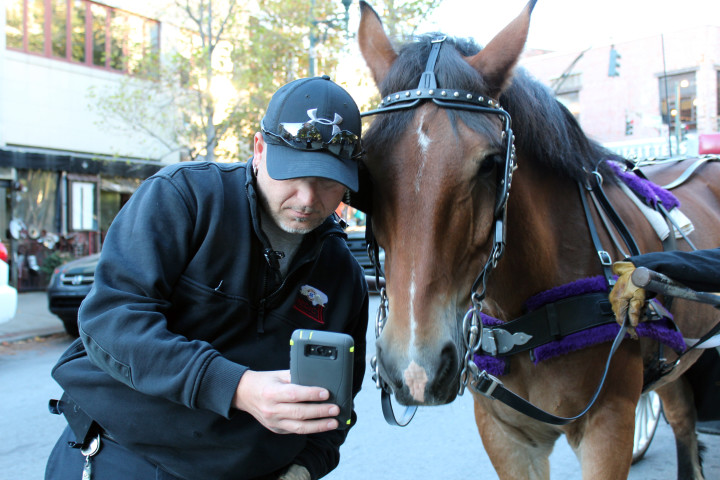
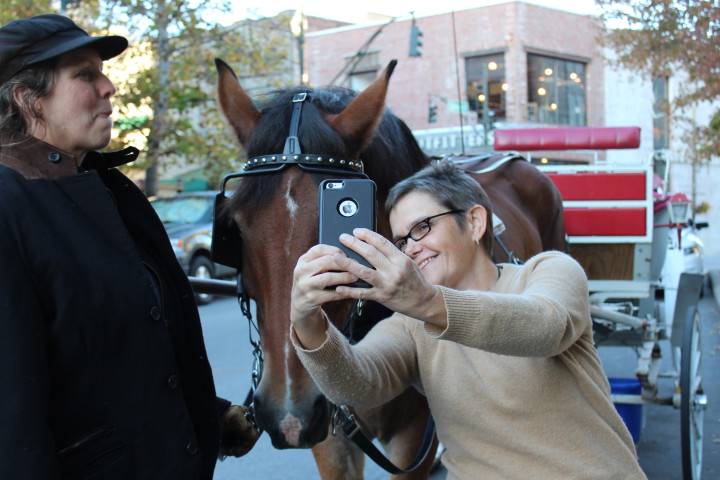
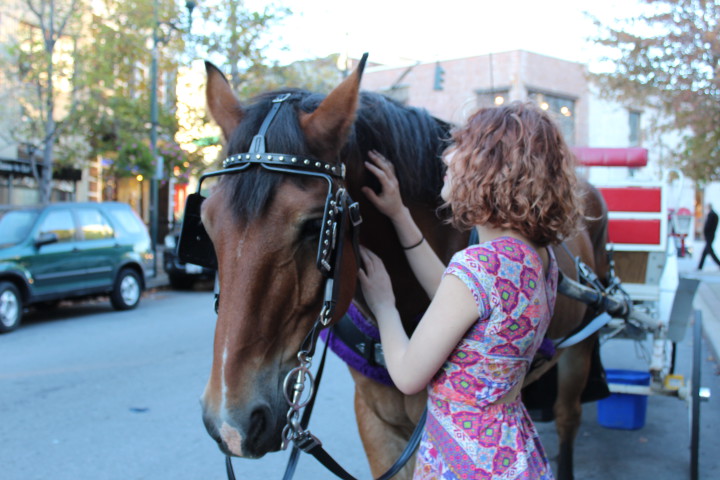
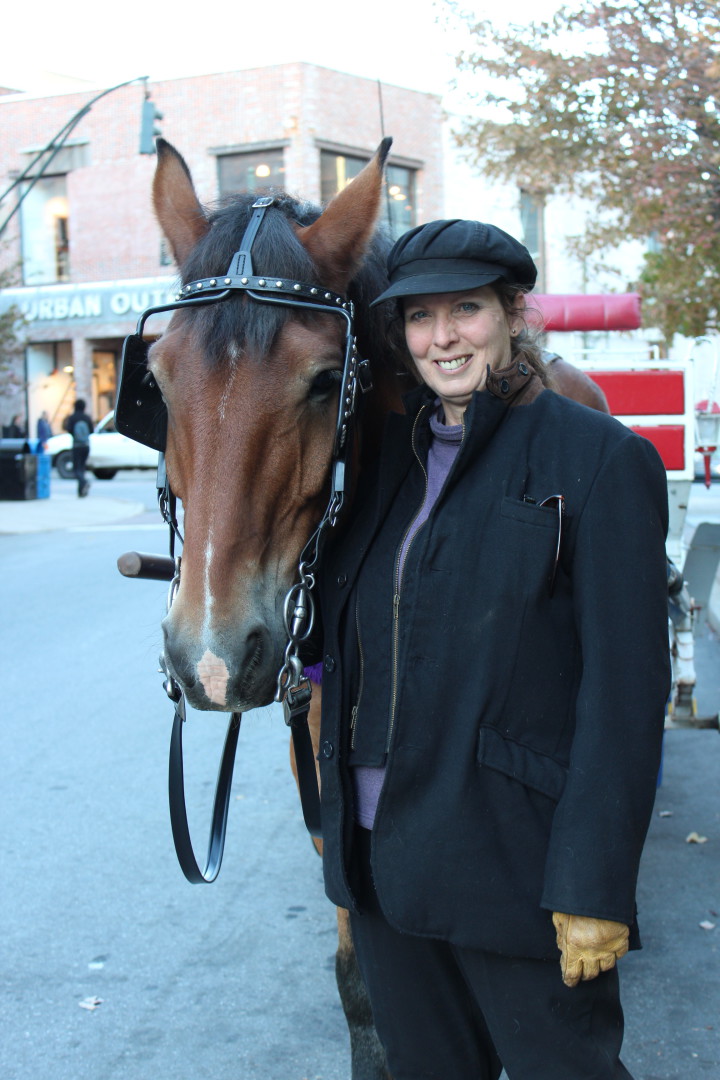
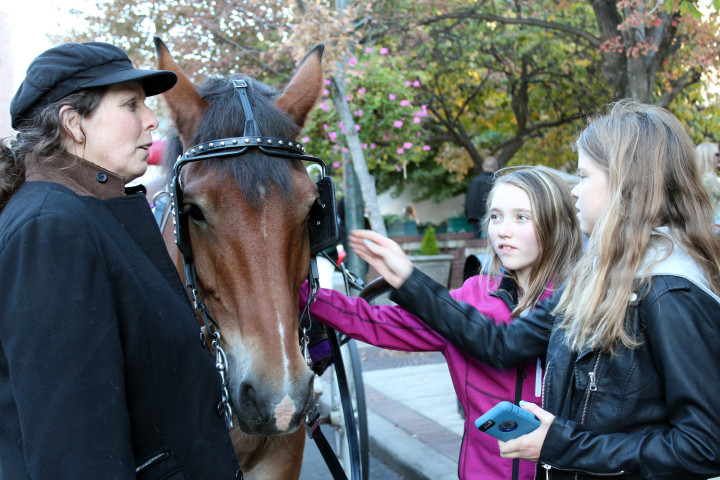
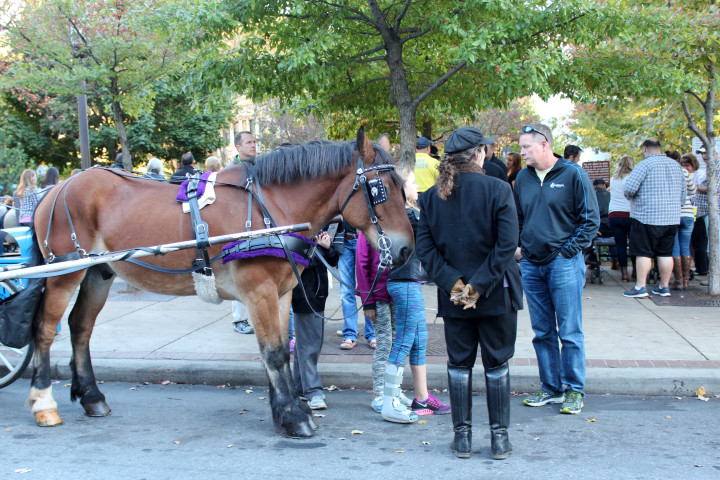
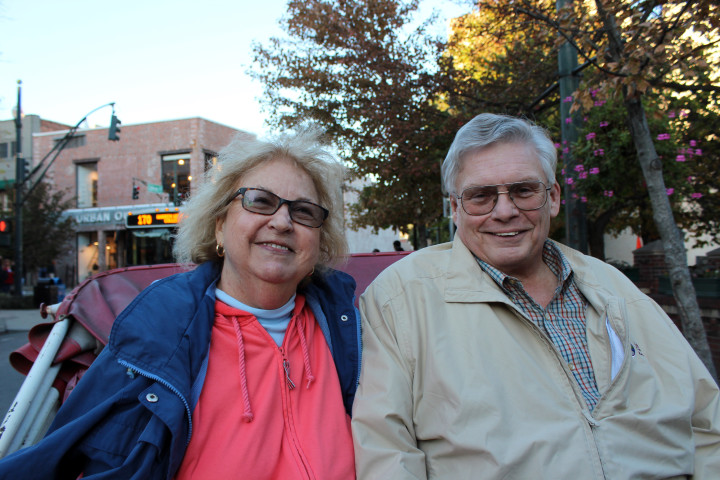

I have personally met Gypsy and I am also an animal activist. I appreciate both but also truly feel that Gypsy is in good hands and is not suffering. You can tell Gypsy likes to be approached and handled. Hunter treats Gypsy very gently and makes sure that all who approach are also gentle.
So, basically, we have a horse who is treated well, doing a job that horses have been bred to do and which they have performed for thousands of years.
Sometimes I wonder if Asheville’s delight in focusing on non-problems like this comes because we know we currently do not have the creativity needed to solve the real problems facing this city.
“Asheville’s delight in focusing on non-problems like this” comes from being a town that is infested with people who list “activist” on their resumes so they can feel good about themselves and not focus on their irrelevance. If all of the city’s problems were to be miraculously solved overnight, the next morning they would invent a new list of problems to protest and agitate against.
“One, Two, Three Four, we don’t want to go to………WORK today!”
As I noted in the article, “Horses shouldn’t be walking on pavement; the excessive pounding is hard on their hooves and legs and leads to lameness. And they shouldn’t be forced to live nose-to-tailpipe, breathing noxious vehicle emissions. Forcing a horse to pull a carriage full of people uphill is cruel, and doubly cruel in hot weather.” Just because horses have been historically abused by humans does not make it right. We can evolve and decide to do our best to live in ways that don’t harm other beings.
But, ethics aside, let’s look for an independent view about public safety. If you read the ordinance, you will see that horse drawn carriages are banned in downtown Asheville during the hours of 11:30 a.m. to 1:30 p.m. and 4:45 p.m. to 5:30 p.m. Monday through Friday. Why is this? Because in 1993, when the ordinance was enacted, the Ashevlle City Council thoroughly studied the issue and determined that having horses pulling carriages on downtown streets is dangerous during times of high traffic.
Those of us who lived in Asheville in the early 1990’s know just how sleepy things were downtown back then. Fast-forward 20 plus years, and Asheville streets are jammed most of the time. A busy weekend night, which is when the carriage operates, is much, much busier than it was 20 years ago between 11:30 a.m. to 1:30 p.m. and 4:45 p.m. to 5:30 p.m.on weekdays. If the increased automobile, bicycle and foot activity is not enough to cause an accident, add to the mix some of the noises that might spook a horse: drum circles, tour buses and trolleys with megaphones, a pubcycle, buskers, music blaring from clubs, etc. The unruliness of the downtown scene makes what was happening downtown twenty plus years ago seem like Mayberry. A horse pulling a carriage in traffic is an accident waiting to happen, and it is simply a matter of time before a human or horse is harmed or killed. As this is foreseeable, and previous city council recognized the issue, I won’t be surprised if the injured party or parties sought costly legal action against the city. The current council should follow the logic and wisdom of their predecessors and ban horse-drawn carriages from the downtown area during busy times, which, now, is most of the time, and definitely on weekend evenings.
Unfortunately, it often takes a disaster for elected officials to act. They ignore citizens who ask for laws banning the chaining of dogs, and then pass laws after someone is maimed or killed by a chained dog. The same can be said for ordinances banning the keeping of wild animals. We need to be proactive, not reactive, and learn from what has happened in other communities.
I couldn’t of said it better myself, Stewart!! Thank You!!! Can we get some common sense here people!!!
Teres, there is no common sense in Stewart’s comment. There is no evidence that asphalt is harmful to horse’s legs or that working around traffic is detrimental to their lungs. In fact, there is independent evidence proving the exact opposite. Banning something because of what MIGHT happen is not common sense at all. Otherwise you would have to ban everything in the world. You MIGHT trip and fall, so don’t walk. A tree MIGHT fall on you and kill you, so cut them all down. You MIGHT choke, so don’t eat anything. Common sense says: Make sure the horses are well-fed and healthy. Make sure they and their drivers are well-trained. Make sure their drivers are knowledgeable about all aspects of horse care and can recognize and deal with the signs of distress and discomfort in any individual horse . Work to make the streets safer for ALL who use them- cars, pedestrians, cyclists, and carriages as well. That’s common sense. Banning something because you basically object to it based on personal beliefs not backed by objective fact is not common sense at all.
I am unconcerned with the animal rights argument. As far as I’m concerned its drivel to assume that solely because an animal is being worked it is being abused. Certainly, some situations may be abusive, but from the info we have about the owner/operator here I think that is pretty clearly not the case.
On the other hand, it does sadden me to see the carriage traversing our streets. Not because of what it says about our treatment of animals, but because of what it says about our city. If there is a more tired cliche of tourism I find it hard to call to mind. But while it may make me cringe, as long as a few tourist hearts flutter I suppose it will carry on. Welcome to Asheville.
I predict that within five years we will be saying the same thing about the damned pub-cycle.
Aawww, c’mon Big Al…..
Don’t be knocking Pub-cycle, it is a ton of fun with the right group. I think it’s a brilliant idea, have ridden 3 times and will ride some more.
Regarding traffic comments from Troubled Traveler — I would sure love to know if the city has measured, in some way, the amount of downtown traffic that is circling while looking for parking. I generally go downtown on week nights so, rarely have a problem. But, boy, the couple of times I’ve been there at mid-day during the week or some weekend nights were an eye-opener as no parking was to be found, I SAW that a good bit of the traffic was a group of us circling and looking.
Adequate parking will make a noticeable difference in traffic downtown.
Our city officials have congested our streets by reducing traffic lanes and employing dangerous traffic control obstacles to create the illusion of a sleepy mountain village to make our downtown appealing to those that might visit (spend their money in) our city. We’ve allowed city officials to obstruct our walkways turning them into performance venues for shows and performers that are primarily concerned with their own personal interests, rather than managing this incredible spectacle so that the broadest spectrum of interests can be met.
I agree with Stewart (and appreciate his/her clarity) I think we’ve painted ourselves into just the exact corner that we had in mind….
Gypsy is happy, healthy and well-cared for. I am an animal lover and really have a problem with all of these activists who not only think they know what is best for SOMEONE ELSE’S animal, but have no problem trying to destroy their livelihoods with lies and malicious gossip and imposing their beliefs on someone else. Stewart and his ilk are misguided, wrong and guilty of harassing a woman who is trying to make a living with a horse she clearly loves.
Stewart, asphalt was designed to make it easier for horses to pull loads. Unless they are galloping up and down the streets, there is no concussion issue. And unless the carriages are pulled by miniatures, then the horses are hardly “nose to tailpipe”. The exact same rhetoric was used against the NYC carriage horses. An independent study was done by the AAEP (American Association of Equine Practitioners) who found that the NYC horses have a much lower incidence of respiratory problems than that of other stabled horses. And these horses walk through some of the most congested streets in America on their way to Central Park. Your arguments on these “ethics” are taken word for word from PETA propaganda and have been proven over and over to be simply untrue. Your term “forcing” when talking about horses pulling carriages is an emotional portrayal which has nothing to do with reality. A horse who does not wish to pull a carriage has a myriad of way of displaying his or her displeasure. To say that the horse is anything but a willing partner is to completely misunderstand the partnership between horse and driver. Carriages are light enough for drivers to move them on their own. Horses are incredibly strong. If the horse was straining to pull a load, he would be “laying in his traces” (leaning his body weight forward, just like a human would lean forward when pulling a heavy load). I have yet to see one picture of a horse pulling a loaded carriage that shows even a small amount of strain on the horse’s part. Pulling a load is actually much easier than carrying it. It’s the same for humans. Think about pushing a loaded grocery cart vs. carrying your bags. Horses weigh 10 times as much as we do, and pound for pound are much stronger. Your arguments for their physical well-being are simply anthropomorphic projections and do not have any basis in fact. And by your argument that the horses should be banned because carriages in traffic are an “accident waiting to happen”, then ALL traffic should be banned because there will most certainly be accidents involving cars, and possibly bicycles, pedestrians, etc. In New York city where the traffic, noise level, and activity level is much higher on a daily basis than in your city, the factual statistics prove that horse-drawn carriages are actually the SAFEST mode of transportation (including walking) on the city streets. While your reply sounds very well-thought out and intelligent, it is based on false premises making the whole thing invalid. Other than personal opinion, there is no factual evidence whatsoever to ban horse drawn carriages as long as each individual horse’s physical and mental needs are being met.
If you feel that the horses and the public are safe- Please read the following.
http://www.mediapeta.com/peta/PDF/horse-drawn-carriage-accidents.pdf
Asheville is no differant than any other city. In fact , the comparison is 6 Million tourist annually to Charleston and 9 million is a frightening number. We have more narrow streets, More congested streets, more buss and tourist attractions than even Charleston. A horse carriage in Asheville is a ticking time bomb. And in our litigious nation an accident on asheville streets could cost the Asheville taxpayer in a liability case.
http://aldf.org/blog/legally-brief-traffic-reports-finally-released-in-horse-carriage-accidents/
If you are truly interested in the health issues associated with the carriage horse industry, see the facts from the Humane society.
http://www.hsvma.org/the_urban_carriage_horse_ride#.VjfSfPmrSUk
Asheville Voice for Animals is devoted to making life better for all sentient beings and will work to stop the exploitative abuse of animals in any and all situations in our city. Outdated, abusive and cruel, cultural practises must be amended in order to move our city into the next century.
The abuse of circus animals for entertainment, chaining dogs to control and neglect them, the sale for profit of imported exotic animal in the animal trade, The sale of hides from abused, neglected, and tortured animals and the harm to Horses on the streets of our city are all issues to be addressed. These outdated, abusive and torturous cultural aspects of yesterday must be abolished.
As an equine body worker who has been out and done body work on Gypsy, I can honestly say that this horse is suffering no muscular skeletal damage from the work he is doing. He is in great shape and has no major structural issues. Sure he had some tight muscles, but nothing of concern. I reguarly work on horses not pulling carriages, and are instead standing outside grazing all day, that have more issues in their muscular system than this big guy. This horse is 17 and has been pulling a carriage most of his life and has less going on in his muscular skeletal system than Ms. Hunter’s other horse I worked on, a quarter horse mare she rescued that is half Gypsy’s age. In my opinion, the work is good for him. It is keeping him healthy, fit, and sound.